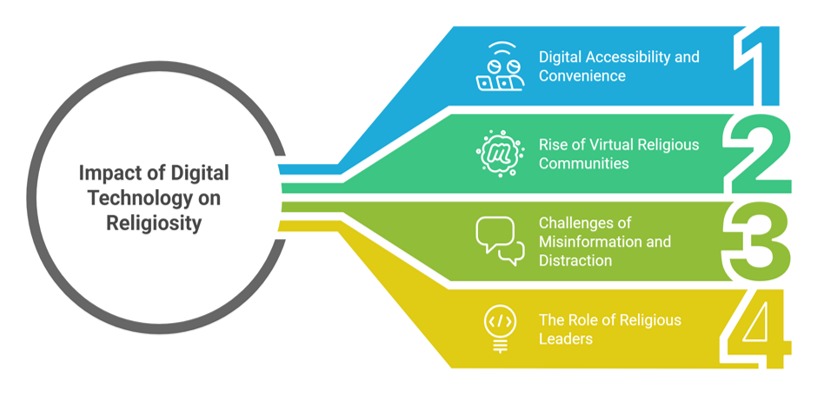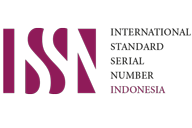Sustaining Digital Faith: How Technology Impacts Religious Activities and Participation in the Digital Era
DOI:
https://doi.org/10.69526/bir.v1i2.338Keywords:
Digital Faith, Technology and Religiosity, Virtual Worship, Online Spiritual Communities, Religious Leaders and TechnologyAbstract
The digital age has significantly transformed religious practices, presenting both opportunities and challenges for individuals and communities. This study examines the impact of technology on religiosity, focusing on the shift from traditional religious practices to digital formats. Using secondary data, the research explores how digital tools like online platforms and virtual communities have reshaped religious engagement and community building. Despite the benefits of accessibility, such as the convenience of attending services remotely and accessing religious resources online, challenges also emerge. These include misinformation, distractions, and the potential erosion of personal spiritual experiences, which can undermine the authenticity of religious practices. The findings suggest that while technology offers greater accessibility to religious resources, religious organizations and leaders must balance virtual engagement with maintaining the integrity of traditional spiritual practices. The study concludes with recommendations for integrating faith into the digital landscape while preserving the core values of spirituality. This includes promoting responsible use of technology, fostering virtual spaces that encourage meaningful engagement, and ensuring that digital tools serve as enhancements, not replacements, for authentic spiritual experiences.
References
K. Barzilai-Nahon and G. Barzilai, “Cultured Technology: The Internet and Religious Fundamentalism,” Inf. Soc., vol. 21, no. 1, pp. 25–40, Jan. 2005, doi: https://doi.org/10.1080/01972240590895892.
I. Levin and D. Mamlok, “Culture and Society in the Digital Age,” Information, vol. 12, no. 2, p. 68, Feb. 2021, doi: https://doi.org/10.3390/info12020068.
M. M. A. Sholeh, Waston, A. Nirwana, and M. Mahmudulhassan, “The Reasons of Lifelong Education for the Sustainable Development Goals (SDGs): The Islamic Epistemology Perspective,” J. Lifestyle SDGs Rev., vol. 5, no. 2, p. e02988, Nov. 2024, doi: https://doi.org/10.47172/2965-730X.SDGsReview.v5.n02.pe02988.
A. N. A.N., M. Mahmudulhassan, F. D. Marshal, M. Muthoifin, and N. Fadli, “Human rights and social justice in Quranic contexts: a global trend,” Leg. J. Ilm. Huk., vol. 32, no. 2, pp. 453–471, Sep. 2024, doi: https://doi.org/10.22219/ljih.v32i2.35088.
K. Tran and T. Nguyen, “Preliminary Research on the Social Attitudes toward AI’s Involvement in Christian Education in Vietnam: Promoting AI Technology for Religious Education,” Religions, vol. 12, no. 3, p. 208, Mar. 2021, doi: https://doi.org/10.3390/rel12030208.
D. Guest, A. Knox, and C. Warhurst, “Humanizing work in the digital age: Lessons from socio-technical systems and quality of working life initiatives,” Hum. Relations, vol. 75, no. 8, pp. 1461–1482, Aug. 2022, doi: https://doi.org/10.1177/00187267221092674.
Ardiansyah et al., “Tracing Trends in Quran Memorization and Cognitive Learning: A Bibliometric Analysis from the Scopus Database,” Pakistan J. Life Soc. Sci., vol. 22, no. 2, pp. 1493–1509, 2024, doi: https://doi.org/10.57239/PJLSS-2024-22.2.00105.
Mahmudulhassan, W. Waston, A. Nirwana, S. Amini, M. M. A. Sholeh, and M. Muthoifin, “A moral-based curriculum to improve civilization and human resource development in Bangladesh,” Multidiscip. Rev., vol. 7, no. 8, p. 2024137, May 2024, doi: https://doi.org/10.31893/multirev.2024137.
A. Akrim, “A New Direction of Islamic Education in Indonesia: Opportunities and Challenges in the Industrial Revolution Era 4.0,” Edukasi Islam. J. Pendidik. Islam, vol. 11, no. 01, p. 35, Feb. 2022, doi: https://doi.org/10.30868/ei.v11i01.1799.
P. Phillips, K. Schiefelbein-Guerrero, and J. Kurlberg, “Defining Digital Theology: Digital Humanities, Digital Religion and the Particular Work of the CODEC Research Centre and Network,” Open Theol., vol. 5, no. 1, pp. 29–43, Jan. 2019, doi: https://doi.org/10.1515/opth-2019-0003.
C. Helland, “Digital Religion,” in Handbooks of Sociology and Social Research, 2016, pp. 177–196. doi: https://doi.org/10.1007/978-3-319-31395-5_10.
H. O. Brien, “What does the rise of digital religion during Covid-19 tell us about religion’s capacity to adapt?,” Irish J. Sociol., vol. 28, no. 2, pp. 242–246, Aug. 2020, doi: https://doi.org/10.1177/0791603520939819.
A. N. AN, . M., . M., and . W., “Bibliometric Analysis of Islamic Education and Character Development in Religious Education Practices in Indonesia,” Pakistan J. Life Soc. Sci., vol. 22, no. 2, pp. 1231–1245, 2024, doi: https://doi.org/10.57239/PJLSS-2024-22.2.0086.
Muthoifin et al., “Fostering Multicultural Community Harmony to Enhance Peace and Sustainable Development Goals (SDG’s),” J. Lifestyle SDGs Rev., vol. 5, no. 1, p. e01687, Oct. 2024, doi: https://doi.org/10.47172/2965-730X.SDGsReview.v5.n01.pe01687.
Sukisno, Waston, A. Nirwana, Mahmudulhassan, and M. Muthoifin, “Parenting problems in the digital age and their solution development in the frame of value education,” Multidiscip. Rev., vol. 7, no. 8, p. 2024163, Apr. 2024, doi: https://doi.org/10.31893/multirev.2024163.
S. U. A. Khondoker, Waston, A. N. An, Mahmudulhassan, and Muthoifin, “The Role of Faith-Based Education in Bangladesh’s Multicultural System and Its Impact on the Sustainable Development Goals (SDGs),” J. Lifestyle SDGs Rev., vol. 5, no. 2, p. e03472, Dec. 2024, doi: https://doi.org/10.47172/2965-730X.SDGsReview.v5.n02.pe03472.
Muthoifin et al., “An Interfaith Perspective on Multicultural Education for Sustainable Development Goals (SDGS),” J. Lifestyle SDGs Rev., vol. 4, no. 3, p. e01720, Sep. 2024, doi: https://doi.org/10.47172/2965-730X.SDGsReview.v4.n03.pe01720.
M. Ossewaarde, “Digital transformation and the renewal of social theory: Unpacking the new fraudulent myths and misplaced metaphors,” Technol. Forecast. Soc. Change, vol. 146, no. October 2018, pp. 24–30, Sep. 2019, doi: https://doi.org/10.1016/j.techfore.2019.05.007.
R. W. Joubert, “Occupational catastrophe! The digital revolution, global warming, unrest and pandemics: are we prepared?,” South African J. Occup. Ther., vol. 50, no. 2, pp. 77–83, Sep. 2020, doi: https://doi.org/10.17159/2310-3833/2020/vol50no2a10.
S. Ekasari, S. Orba Manullang, A. Wahab Syakhrani, and H. Amin, “Understanding Islamic Education Management in Digital Era: What Experts Say,” Nidhomul Haq J. Manaj. Pendidik. Islam, vol. 6, no. 1, pp. 127–143, 2021, doi: https://doi.org/10.31538/ndh.v6i1.1336.
D. Vicky, H. Adrianna, and B. Phan, “Use of Gadgets by Early Childhood in the Digital Age to Increase Learning Interest,” Sci. J. Sci. Technol., vol. 2, no. 1, pp. 17–34, Apr. 2023, doi: https://doi.org/10.55849/scientechno.v2i1.58.
A. N. AN, Mahmudulhassan, Muthoifin, Waston, and S. Hidayat, “Research Trends In Quranic And Biblical Studies: A Bibliometric Analysis Of Islamic And Christian Scholarship (2019-2024) Andri Nirwana. AN*, Mahmudulhassan, Muthoifin, Waston, Syamsul Hidayat Faculty of Islamic Studies, Universitas Muhammadiyah Surakarta,” Rev. Iberoam. Psicol. DEL Ejerc. Y EL Deport., vol. 19, no. 4148, pp. 343–349, 2024.
F. Mubarak and R. Suomi, “Elderly Forgotten? Digital Exclusion in the Information Age and the Rising Grey Digital Divide,” Inq. J. Heal. Care Organ. Provision, Financ., vol. 59, pp. 1–7, Jan. 2022, doi: https://doi.org/10.1177/00469580221096272.
K. Hutchison, L. Paatsch, and A. Cloonan, “Reshaping home–school connections in the digital age: Challenges for teachers and parents,” E-Learning Digit. Media, vol. 17, no. 2, pp. 167–182, Mar. 2020, doi: https://doi.org/10.1177/2042753019899527.
M. Mahmudulhassan, W. Waston, and A. Nirwana AN, “The Rights and Status of Widows in Islam: A Study from the Perspective of Multicultural Islamic Education in the Context of Bangladesh,” Multicult. Islam. Educ. Rev., vol. 1, no. 1, pp. 01–14, Sep. 2023, doi: https://doi.org/10.23917/mier.v1i1.2674.
M. R. Rifat, T. Toriq, and S. I. Ahmed, “Religion and Sustainability,” Proc. ACM Human-Computer Interact., vol. 4, no. CSCW2, pp. 1–32, Oct. 2020, doi: https://doi.org/10.1145/3415199.
S. Gupta, A. Leszkiewicz, V. Kumar, T. Bijmolt, and D. Potapov, “Digital Analytics: Modeling for Insights and New Methods,” J. Interact. Mark., vol. 51, no. 1, pp. 26–43, Aug. 2020, doi: https://doi.org/10.1016/j.intmar.2020.04.003.
M. Mahmudulhassan, W. Waston, M. Muthoifin, and S. U. Ahmed Khondoker, “Understanding the Essence of Islamic Education: Investigating Meaning, Essence, and Knowledge Sources,” Solo Univers. J. Islam. Educ. Multicult., vol. 2, no. 01, pp. 27–36, Mar. 2024, doi: https://doi.org/10.61455/sujiem.v2i01.115.
G. M. Harari et al., “Personality Sensing for Theory Development and Assessment in the Digital Age,” Eur. J. Pers., vol. 34, no. 5, pp. 649–669, Sep. 2020, doi: https://doi.org/10.1002/per.2273.
M. Becker, “Privacy in the digital age: comparing and contrasting individual versus social approaches towards privacy,” Ethics Inf. Technol., vol. 21, no. 4, pp. 307–317, Dec. 2019, doi: https://doi.org/10.1007/s10676-019-09508-z.
Mahmudulhassan, M. Abuzar, L. Yafi, I. Afiyah, and I. Amelia, “Strategy and Implementation of Islamic Personality Development through the Internalization of Religious Values at Madrasah Aliyah Dakka , Bangladesh,” Solo Univers. J. Islam. Educ. Multicult., vol. 2, no. 2, pp. 167–180, 2024, doi: https://doi.org/10.61455/sujiem.v2i02.201.
L. Fitouchi, M. Singh, J.-B. André, and N. Baumard, “Prosocial religions as folk-technologies of mutual policing.,” Psychol. Rev., Feb. 2025, doi: https://doi.org/10.1037/rev0000531.
S. Suherlan and M. O. Okombo, “Technological Innovation in Marketing and its Effect on Consumer Behaviour,” Technol. Soc. Perspect., vol. 1, no. 2, pp. 94–103, Oct. 2023, doi: https://doi.org/10.61100/tacit.v1i2.57.
Mahmudulhassan, Muthoifin, and S. Begum, “Artificial Intelligence in Multicultural Islamic Education : Opportunities , Challenges , and Ethical Considerations,” Solo Univers. J. Islam. Educ. Multicult., vol. 2, no. 1, pp. 19–26, 2024, doi: https://doi.org/10.61455/sujiem.v2i01.114.
A. E. Cladis, “A shifting paradigm: An evaluation of the pervasive effects of digital technologies on language expression, creativity, critical thinking, political discourse, and interactive processes of human communications,” E-Learning Digit. Media, vol. 17, no. 5, pp. 341–364, Sep. 2020, doi: https://doi.org/10.1177/2042753017752583.
S. Ashton, K. McDonald, and M. Kirkman, “What does ‘pornography’ mean in the digital age? Revisiting a definition for social science researchers,” Porn Stud., vol. 6, no. 2, pp. 144–168, Apr. 2019, doi: https://doi.org/10.1080/23268743.2018.1544096.
C. Nikmatullah, W. Wahyudin, N. Tarihoran, and A. Fauzi, “Digital Pesantren: Revitalization of the Islamic Education System in the Disruptive Era,” Al-Izzah J. Hasil-Hasil Penelit., p. 1, Jun. 2023, doi: https://doi.org/10.31332/ai.v0i0.5880.
A. Diana, M. Z. Azani, and M. M, “The Concept And Context Of Islamic Education Learning In The Digital Era: Relevance And Integrative Studies,” Profetika J. Stud. Islam, vol. 25, no. 01, pp. 33–44, Feb. 2024, doi: https://doi.org/10.23917/profetika.v25i01.4239.

Downloads
Published
Issue
Section
License
Copyright (c) 2023 Md. Ishaque, Mahmudulhassan Mahmudulhassan, Muhammad Abuzar (Author)

This work is licensed under a Creative Commons Attribution 4.0 International License.



















